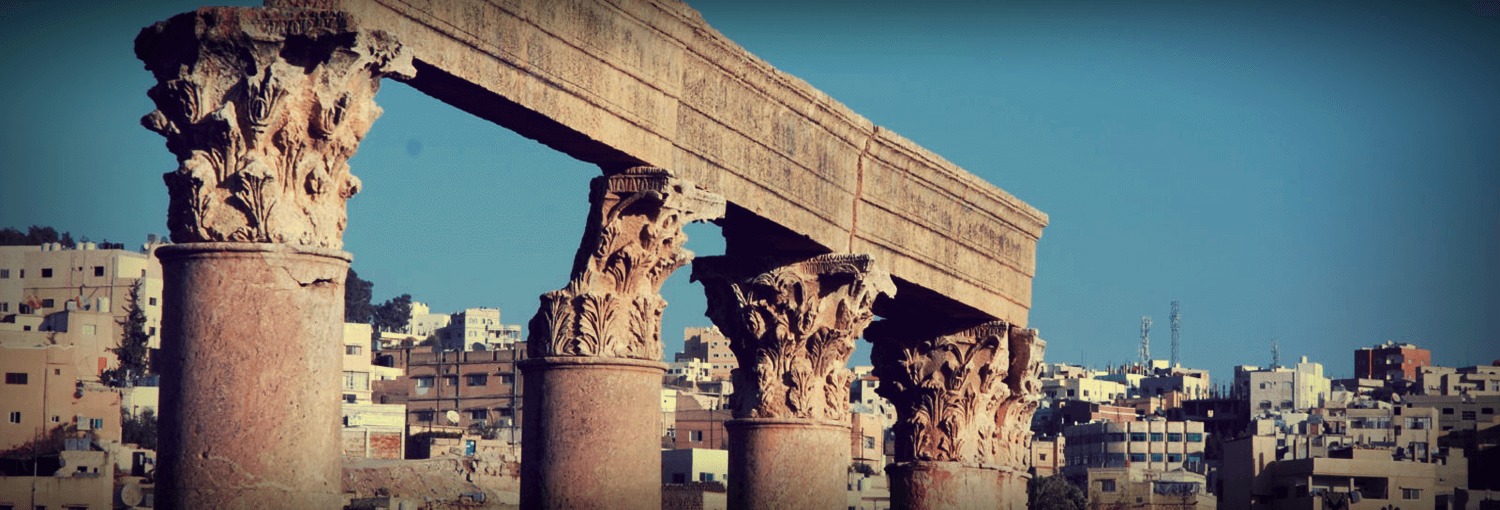
TEMPLE OF ARTEMIS 2018-2020
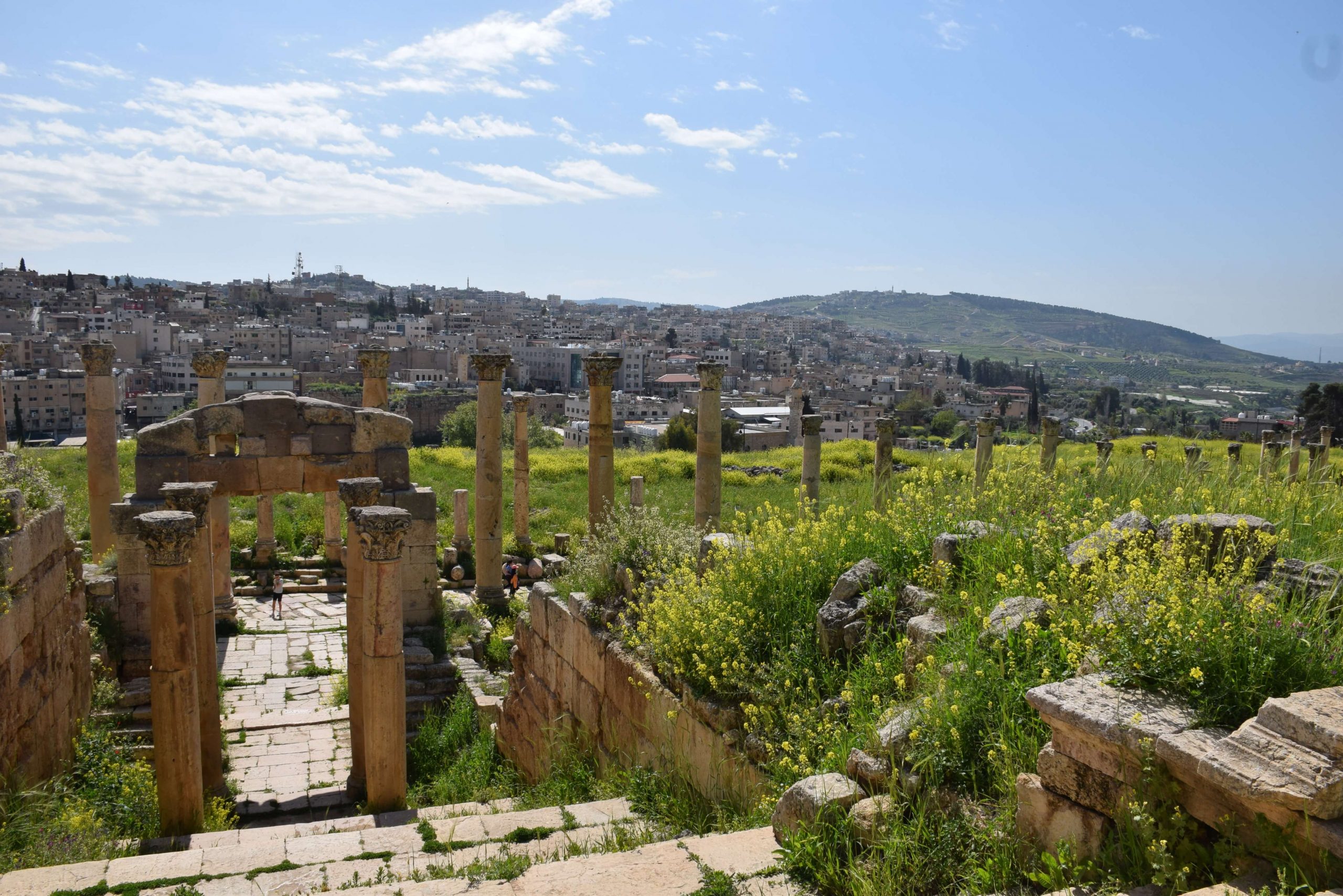
Visit Jerash: What to know
By now it has been a full month that I have been here speaking to visitors almost every day, and through talking to them I realized there are a few things that may be helpful to know before your visit! I have learned so much talking to all of you, and am so happy to hear you all enjoy your visit to Jerash. But for future travelers here are a few tips to plan your…
Continue reading
By now it has been a full month that I have been here speaking to visitors almost every day, and through talking to them I realized there are a few things that may be helpful to know before your visit! I have learned so much talking to all of you, and am so happy to hear you all enjoy your visit to Jerash. But for future travelers here are a few tips to plan your visit perfectly.
1.Getting to Jerash – If you didn’t rent a car here in Jordan the best way to arrive at Jerash is with a taxi. From Amman, the usual going rate is 20JD one way, or 40JD for the day for them to wait for you. Instead if you do have a car, the road directions are fairly straight forward, however, parking is not at the “Visitor Center”. Instead, when looking for parking, search on Google Maps for “Old Roman” Restaurant or Jerash Visitor Car Parking, there you will find a small parking lot if there is little space you may notice cars will park all along the side of the road. Here is a little map to help you out with that:

If you are arriving from Amman you will be on the road
20 coming up on the right, you may turn before
or after you see a small theme park to reach the parking.
2. Buying your ticket– If you have a Jordan Pass you can cut straight through the Market, Hadrians Arch and head towards the entrance at the South Gate. However, if you need to buy your ticket, don’t go that far! The ticket office is located at the very end of the market, on the right across from a small bar. Be absolutely sure to buy your ticket here, there is no other ticket office and it is a long walk to the entrance!
3. Shopping at the Market– Pay attention to what you are buying at the market, most of the time sellers will spit out 10JD as their starting price, feel free to argue this lower (for example one of the stuffed camels should only be about 3JD not 10.). Also, be aware of where and how the goods are made, many are made in China, and from cheap material like polyester. For example, one seller will have small rugs saying they are made with camel fur, if they are bright colors, shiny and smell like plastic, it is clearly not camel fur. That being said, head down the side aisle to the right and you will find quality made rugs and the work of a local artist, definitely worth a look!
4. Visitors Center– many visitors rush to the entrance but take a moment to step off the path and visit the new Visitors Center. Here there is an introduction to the site’s history, a helpful map, brochures to take and a small museum. Also most importantly – Bathrooms.

5. Bathrooms– There are no bathrooms on site. So definitely go before you start your walk they are some located at the Market, the Visitors Center, and the Museum located behind the Oval Forum.
6. Water– There are also no rest stations or bars past the entrance to the site. While you may find sellers with water inside, it is better to come prepared to bring cold water and some snacks to get you through the large site!
7. A word on guides – There are informational panels located in the site to help you identify landmarks, but if you prefer the help of a guide they are available close to the Visitors Center. But a fair warning, you should not be paying 50 or more JD. In fact, I would recommend a rate of 20/30JD. I have heard that some are charging up to 70JD and then leaving the visitors at halfway through the site, without the full tour. So decide what you are going to pay in advance and know the general rates.

A word on some common scams: Unfortunately, like any highly visited sites, Jerash is not 100% clear of certain scams or difficulties. And though we are working with the management and Tourist Police, sometimes we cannot control every situation.
On-site, I have heard many tell me of some vendors or individuals on site who say they will take your photo for you then demand money. This is common all over the world, but just as a reminder, be aware. Also, there is a location just at the beginning of the Cardo to the left called the Macellum, it is a beautiful site and you should have a stop in but pay attention. Two individuals are often sitting here convincing you to go in then start telling you about the location (incorrect information) then ask for money and some have even harassed visitors for up to 15JD. These men are not official tour guides, and not approved by the site. So please, visit the location but do not feel obligated to pay these fake guides, nor accept their mini-tour. Simply repeating “No, Thank You” should be enough.

I really hope that this information has been helpful for planning your upcoming trip to Jerash and that you enjoy! Was there some other tip you think future visitors should know? Comment on this post or send us a note and we will make updates!
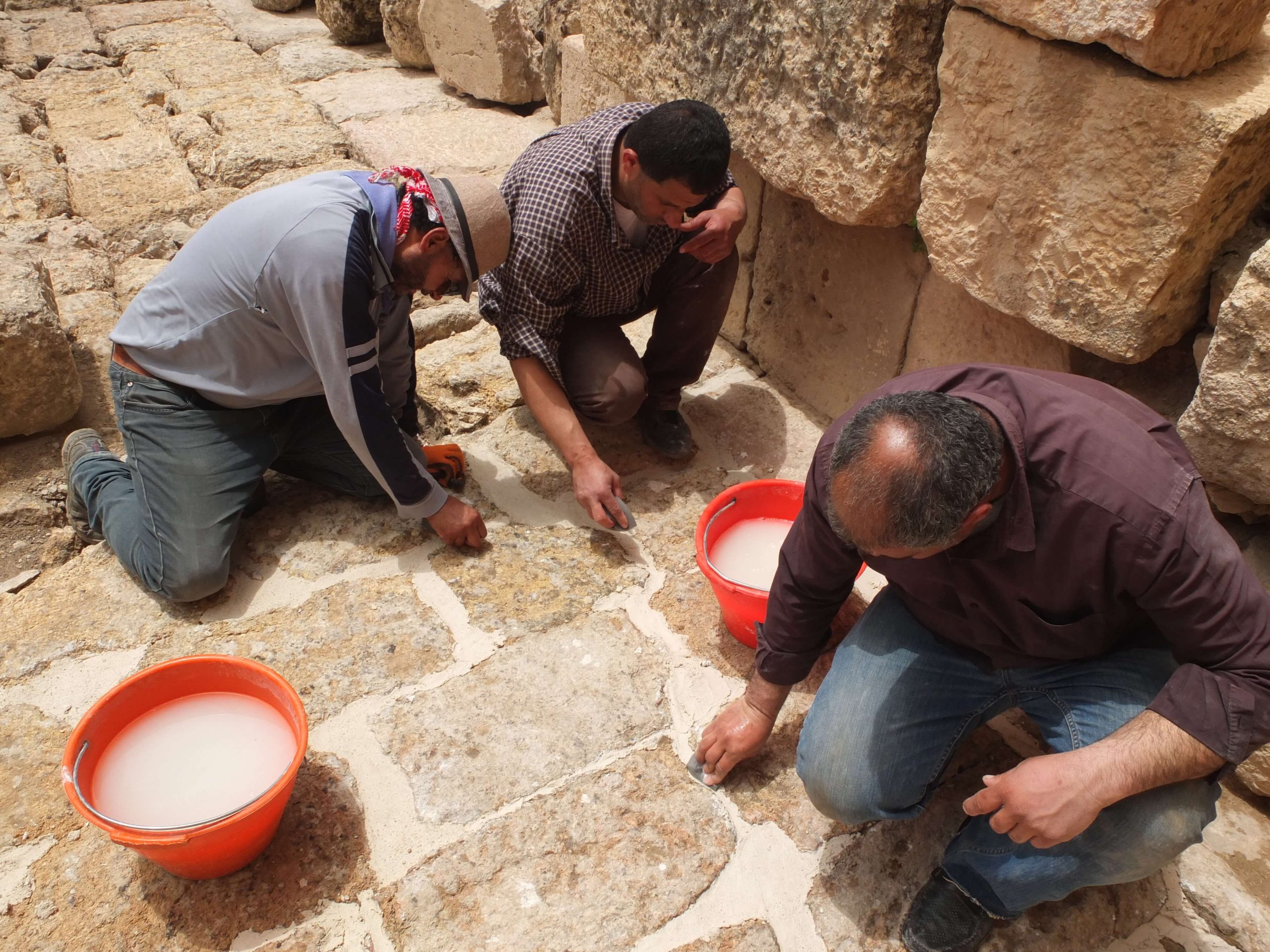
Restoration Work in the Temple of Artemis, Jerash
The current restoration work on the Temple of Artemis Jerash, in Spring 2019.
Continue reading

The restoration work underway in Artemis Temple stems from the need to solve a series of structural problems related to the podium rooms, specifically the three vaults that support the floor of the cella.
Over the centuries, these three barrel vaults built with local limestone have remained devoid of the padding mortar between the joints (it has been worn down by the natural course of events and exposure to the elements), thus compromising the stability of the vaulted structures and consequently the accessibility of the cella, which is currently closed to the public.

The vaults, as well as arches and domes, base their stability on a principle of compression between their elements, which must, therefore, maintain perfect contact.
A modification of the original design during the construction of the temple reduced the thickness of the upper parts of the vaults, thus reducing the load and the contact surfaces.
The loss of mortar between the various elements of these structures has thus generated a gap between one stone and another that affects the static principle on which the vaults themselves are based. Over time, these ‘voids’ have partly been filled with earth and vegetation, replacing the mortar but without guaranteeing the same structural stability.

Fortunately, small flakes of stone, inserted by the temple builders together with the mortar between the ashlars, have remained in place after the washing of the latter and have acted as a wedges avoiding the collapse of the vaults.
The restoration operations, therefore, start from the mechanical removal of the soil deposited and its replacement with new mortar based on natural hydraulic lime and local sands.
Together with this, new wedge elements have been inserted, where necessary, in order to give greater structural support.
Manual tools, electric vacuum cleaners, and compressed water tools guarantee a high level of cleanliness and therefore a greater capacity to perform mortar replacement operations on the ground in the best conditions.
Preventive biocidal treatment of the surfaces of the ashlars has allowed the removal of the plants, mostly lichens, deposited on the extrados of the three vaults. In a second step, the vaults now under restoration will be covered with a rudimentary waterproof flooring to ensure the protection and stability necessary for the viability of the cella and then the reopening to the public.

End of the ‘dry’ cleaning work

Wet cleaning with a high-pressure cleaner.

Mortar filling between the joints of the vaults.

Back to Jerash
What prompts a group of archaeologists and conservators to leave a country overcrowded of archaeological heritage in need of restoration and protection to come and take care of a monument thousands of miles away from home?
Continue reading
Massimo Brizzi
What prompts a group of archaeologists and conservators to leave a country overcrowded of archaeological heritage in need of restoration and protection to come and take care of a monument thousands of miles away from home?
Since 1978, archaeologists, architects, and conservators of the Italian archaeological mission have worked in the Sanctuary of Artemis at Jerash. Together with their Jordanian colleagues, they carried out excavations, processed finds, designed and realized restorations.

Reconstructive elevation of the sanctuary of Artemis by R. Parapetti.
Built in the core of the ancient city of Gerasa, with its sophisticated succession of terraces and elegant architectural façades, the Sanctuary of Artemis is one of the best-preserved masterpieces of the Roman architecture in the world. In a time when the chief architect of the Empire was from Damascus, and in a region that has always been a cultural crossroads, the design of the sanctuary can be considered exemplary of the encounter between the millenary oriental urban culture with the universal language of the Hellenistic and Roman architectonic forms.
Perhaps these arguments could be enough to justify dozens of missions and all the work that has been done in these years. However, archaeological research focused on a single monument, no matter how big or how important, would be nonsense.
Any archaeological object, both masterpiece or simple artifact, lives in a network of relationships, a web of interferences and overlaps that determine their survival and comprehensibility; they are linked to the landscape they belong, they shape it and determine its use, its development, its future. Only by understanding these relationships we have a chance to read their stories and the ones of the people who created and made use of them.
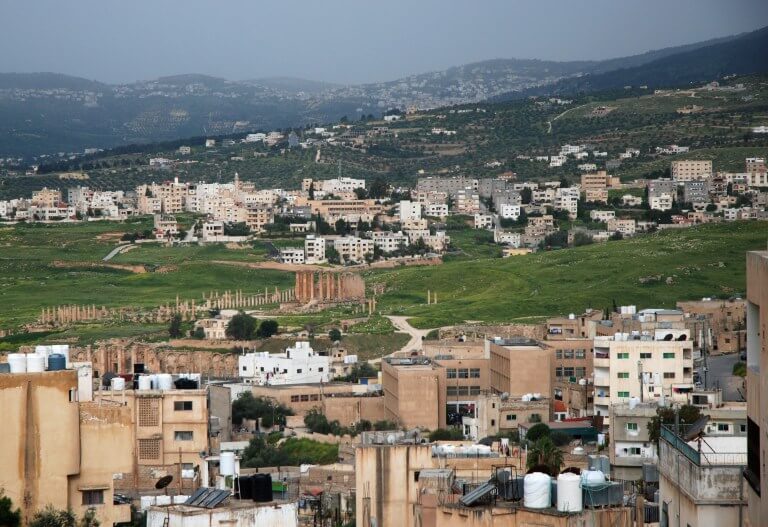
The city of Jerash surrounding the archaeological site.
In forty years of investigations, the sanctuary of Artemis provided hundreds of these stories, cracked from the puzzle of the archaeological record. There are the voices of street traders, the decisions of Roman governors, the offerings of worshippers, the work of potters and stonecutters, the strict intransigence of the early Christians. People from many countries, speaking different languages and believing in different gods. Everyone participant in the local history of the region, a tributary of the greater history of the world.
Designing this project of conservative interventions in the temple of Artemis, we assumed that the conservation of the built heritage depends on half on its physical stability and the other half on ‘being heritage’ in the land it belongs, in other words on its capacity to tell those stories we mentioned to the people living here or visiting this region.
For the first, we will intervene in the critical points of the monument together with our colleagues from the Jordanian Department of Antiquities who at the end of the project will continue to act autonomously in the necessary care and daily maintenance of the temple and all the other monuments of the site. For the second we start an investigation of the people living in Jerash and its visitors, through a visitors’ study and the interviews of some key members of the local community. The results of this survey will provide a base for new strategies of promotion of the site and engagement of the Jerash inhabitants.
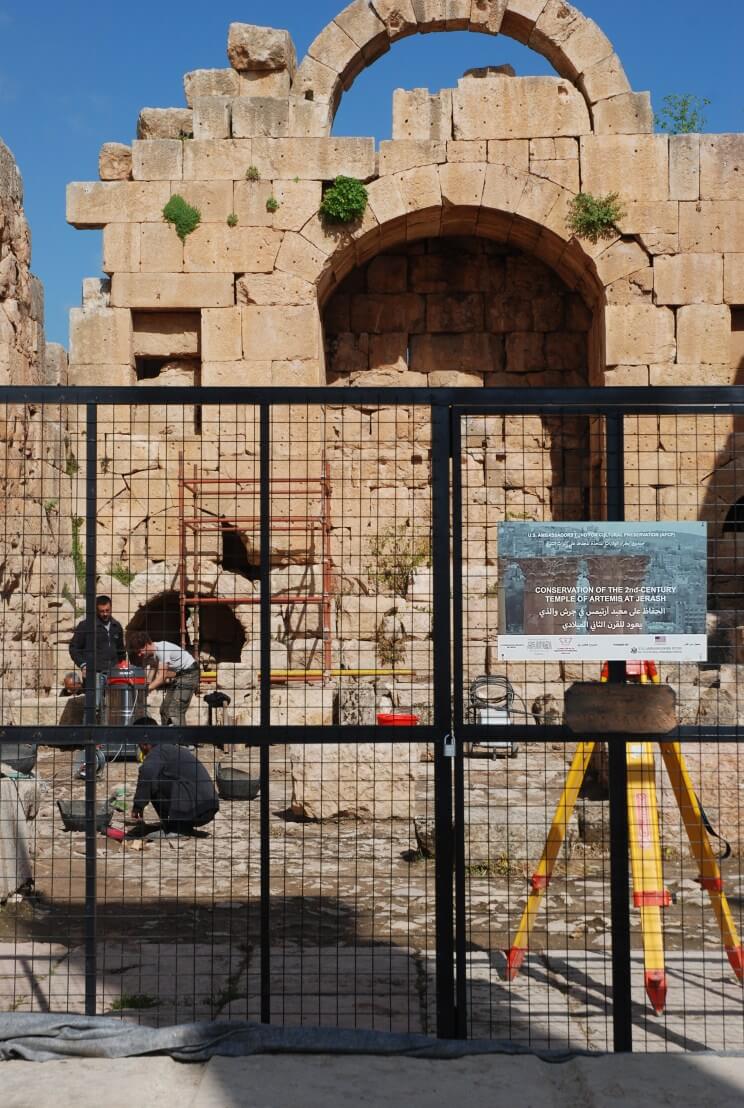
Work of conservation in the Temple of Artemis cella
This project is my third work experience on this site in 25 years. In 1994 the modern city and the archaeological area were two specular halves upon the two banks of the wadi. In the following years, Jerash expanded in a way that the ruins became a sort of fenced park in the middle of the city. Suddenly dozens of sarcophagi were collected near the offices of the Department, a worrying sign: the necropolises around the ancient city had gradually being devoured by the modern houses, the balance between the two cities was broken. In a visionary work during the 80s, Roberto Parapetti emphasized the precariousness of this relationship which, if not adjusted in time, would have turned to the detriment of the ancient city. Raising fences and barricades is definitely a losing move; starting a dialogue that leads to osmosis between the two cities is the only strategy that can save the archaeological area from its debasement in an amusement park for ‘selfies hunters’.
Together with Jerash the whole country has changed. Jordan is today a peaceful country that suffers the consequences of the bloody wars surrounding it like a cyclone. It is estimated that at least one out of three residents is a refugee, figures that make ridicule the hysterical reactions of many European governments and citizens when a boat with a few dozen of desperate migrants approaches. In Jordan the cost of living is at European levels with much lower average wages and the unemployment rate is growing. Despite all this suffering, Jordan is still the country where you meet a stranger on the street and you find yourself dining at home with his family; it is the place where you enter a shop to buy a couple of screws and you are always offered three dates and a glass of tea.
In a moment of crisis, the rules of hospitality, on which our civilization has been based for millennia, could appear as redundant. Equally, the attention to our history seems an extravagance that we cannot afford. Against the tide, with optimistic obstinacy, our project wants to tackle the problems of today as the last layer of the history we are investigating, read and tell the stories of this ancient city to look at and change its future.
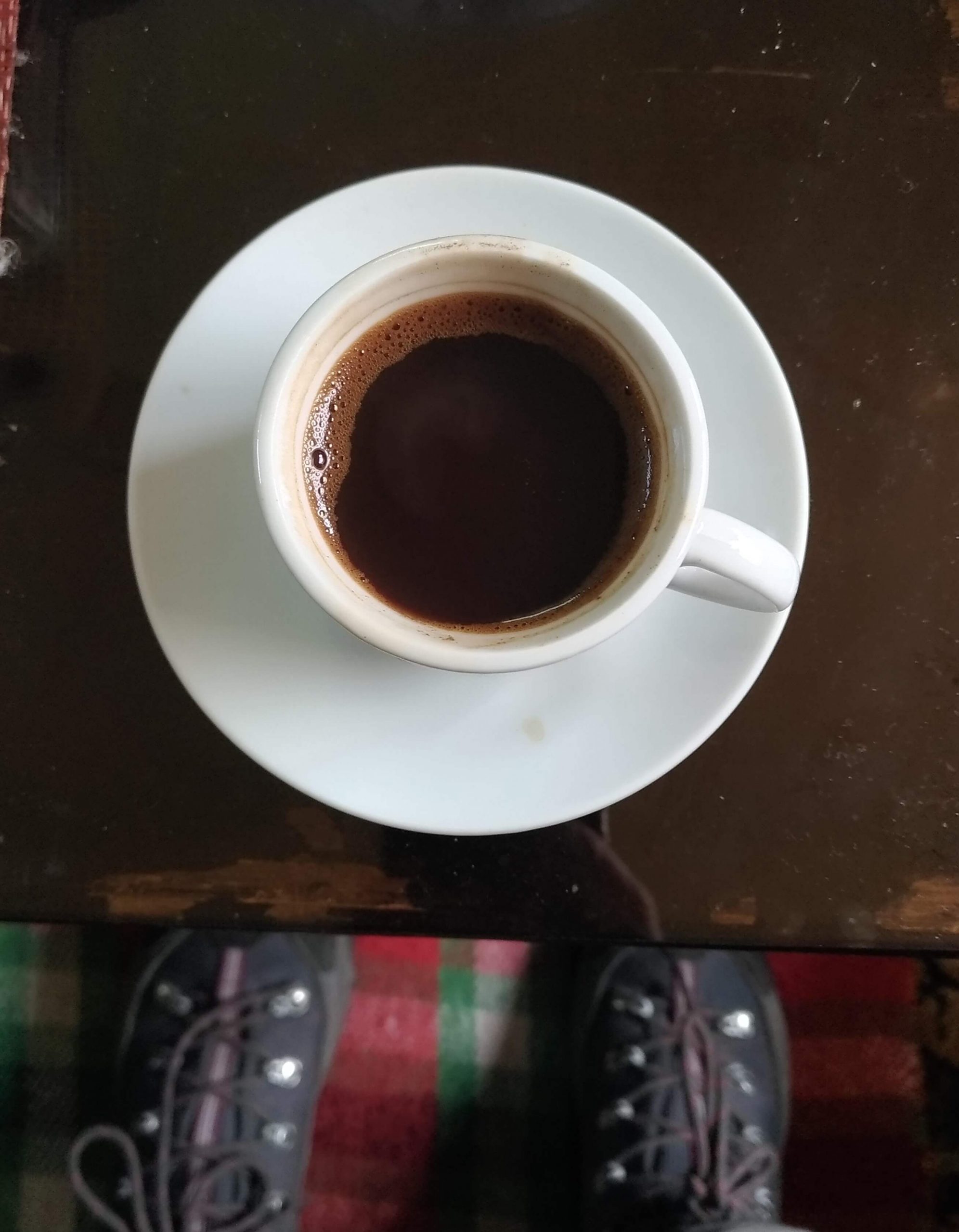
A Warm Welcome to Jerash
An unexpected welcome to Jerash by a local family.
Continue reading
By Evelyn Hill
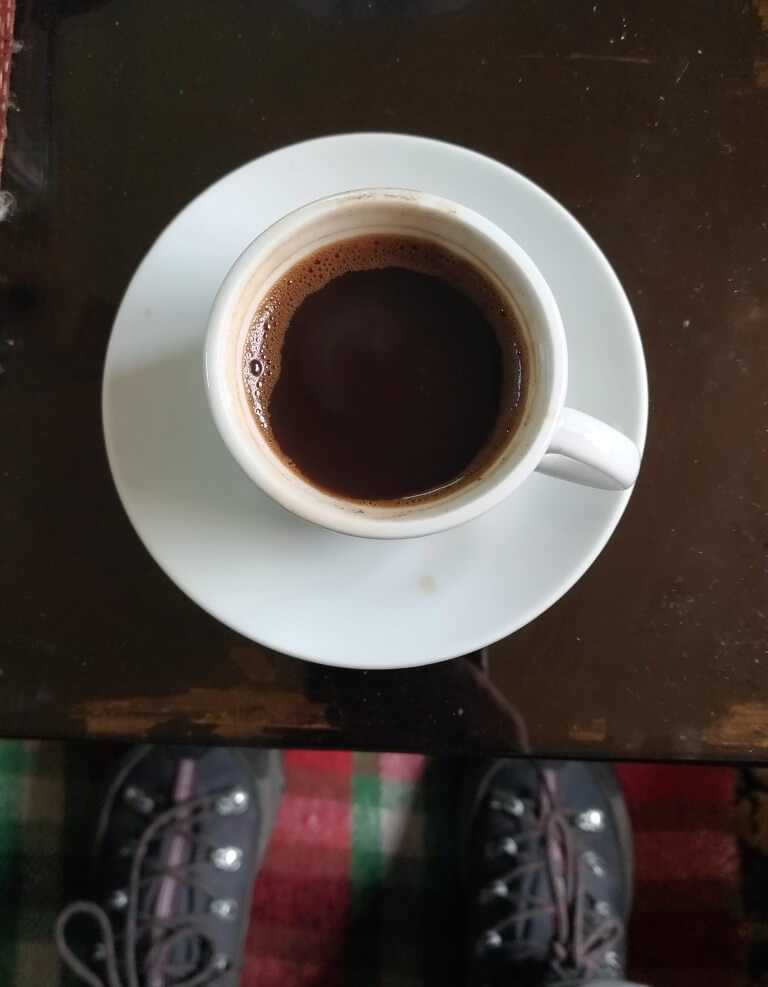
Before coming to Jordan, everything you read will tell you how welcoming and hospitable Jordanians are. But truly, you won’t understand the depths of that hospitality until you see it. Not only will you see smiles everywhere and hear “welcome, welcome” all the time, you will be spontaneously invited to coffee or tea in the homes of total strangers.
That is just what happened on my first day in Jerash.
On a quiet Friday morning we went into town to try and set up our internet, while searching for an open store (imagine Friday in Jordan like Sunday in Italy; everything is closed, the men have gone to pray and then the whole family gets together). A man and his wife stop us from their car. Hello Hello! Welcome Kayfik?! (How are you). We greet them back, while I am assuming that Massimo must know them.
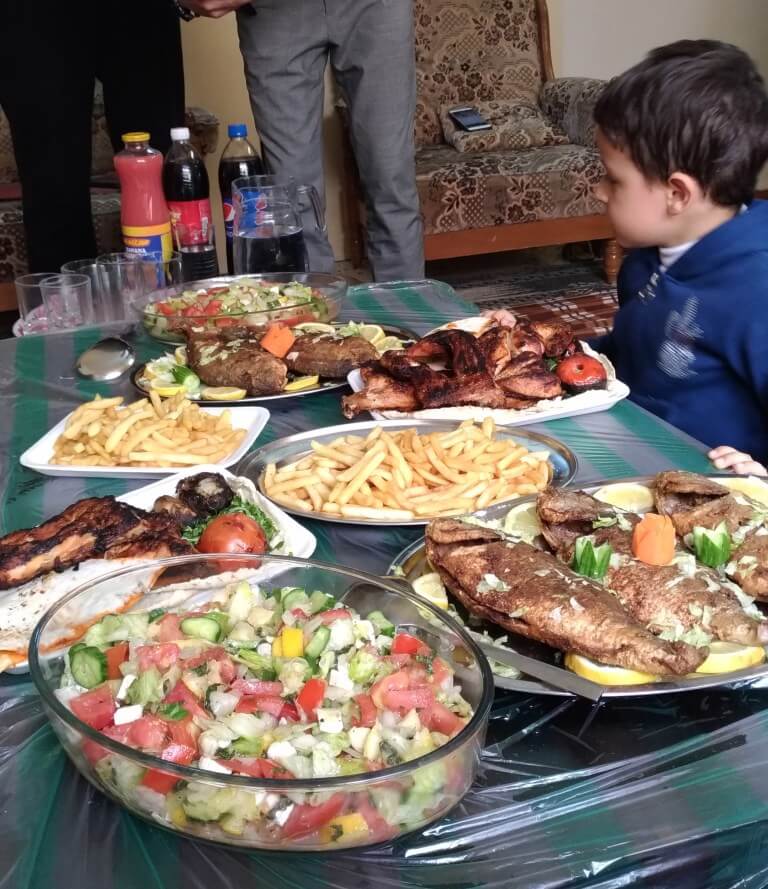
Soon I realize that neither one of us have met them before, but by that point they’ve introduced themselves, and since we could think of no reason to say no, we have accepted their offer for a tea in their home.
A tea became a few hours and coffee, where we learned they had a cousin who had lived in Turin (where I live and Massimo is from), and a son who has traveled the world as a professional violinist. We were shown every corner of their house, given the phone to speak to the son and cousin, and surprisingly kept an excellent conversation going via google translate and the few words we each knew of the others’ language.
Just as we thought we would try to leave, the violinist son, who speaks excellent English, and the other son, a local policeman with his family, all arrived for lunch. And though we tried to politely decline, there was no refusing their kindness and we found ourselves enjoying a Friday family lunch.
Through talking with them we learned that the people of Jerash are very proud of their town, and recognize three distinct parts of Jerash: the Archaeological Park, Old City and New City. They enjoy having both the old city and the archaeological park, but they see these as presenting a difficult situation.
What Islam, their son, pointed out, was that although they have this beautiful park that many come to see, most tourists hop off the bus or taxi, enjoy the site, then drive away, without stepping foot in the city, or enjoying a tea or sweet in town. While the site should be seen as a resource, it actually does not provide much back to the community. They also recognize that Jerash has a lack of hotels and tourist-based businesses. One of the things we are in fact trying to understand from our Tourist study is how many visitors remain in Jerash longer than a few hours. It will be interesting and helpful to see how the data we gather reflects what we have heard so far from the local residents.
In the end we had passed the whole day with the family, and it really was a beautiful unexpected experience. After which I must say, if a Jordanian family invites you to coffee, go ahead and accept, but only if you have nowhere to be for the rest of the day!
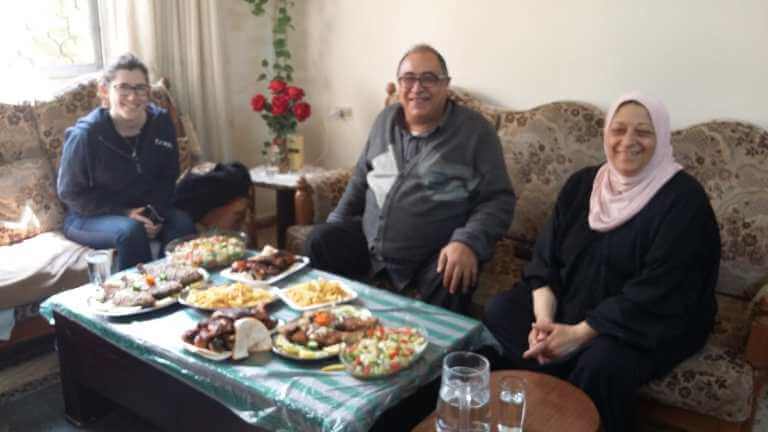

Countries
